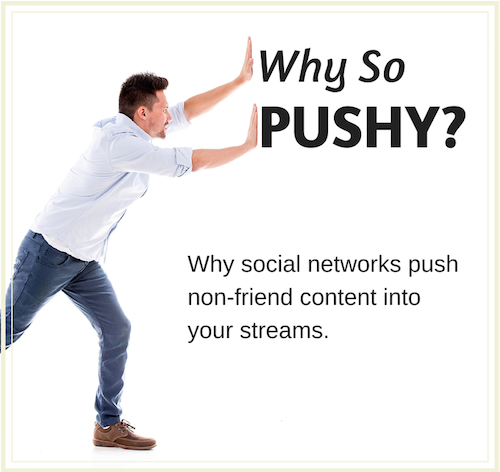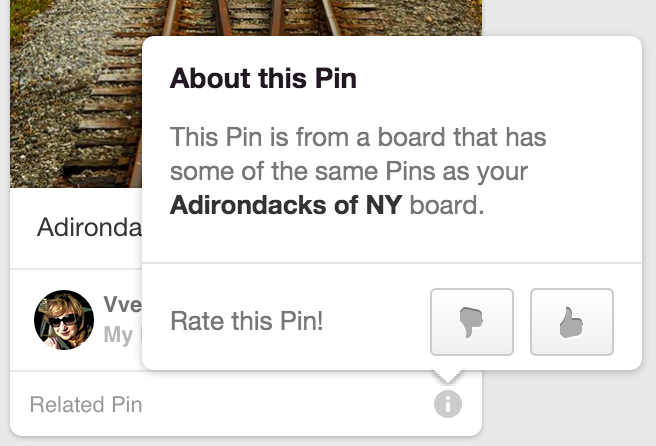Why So Pushy? Why Social Networks Push Non-Friend Content In Your Streams
Despite Facebook's recent throttling of organic reach, it's become increasingly common to see content from people you don't follow in your social feeds.
Some of you may be old enough to remember that bane of the early days of email: the mass forward.
Often passed on to you by your dear Aunt Tillie, these emails were usually forwarded with all caps subject lines like, “OMG I CAN’T BELIEVE WHAT THESE KITTENS JUST ATE!!!”
Of course, such email forwards never really died — they just resurrected themselves on Facebook and at Upworthy.
Mass emails like that existed because people tend to assume that anything which amuses or interests them will surely do the same for their friends and contacts. Nowadays, it appears social networks are making the same assumption and are trying to automate the same effect at scale.
Most of us are already aware that Facebook and Twitter promote paid commercial content into our streams; but increasingly, we’re seeing a trend where more and more networks are pushing unpaid content from “friends of friends” that our friends have engaged with, into our social feeds.
Twitter Jumps In The Pushing Non-Friend Content Pool
The most recent example of this is a move by Twitter to push content from accounts you don’t follow into your stream.
First noticed as a limited experiment to bring in tweets favorited by accounts you follow, it now appears to be a full feature, including not just favorited content but other content Twitter thinks might interest you.
In his post here on Marketing Land breaking this news, Martin Beck quoted from a recent update to the Twitter help page that explains what a user will see in his or her Twitter stream:
[blockquote]Additionally, when we identify a Tweet, an account to follow, or other content that’s popular or relevant, we may add it to your timeline. This means you will sometimes see Tweets from accounts you don’t follow. We select each Tweet using a variety of signals, including how popular it is and how people in your network are interacting with it. Our goal is to make your home timeline even more relevant and interesting.[blockquote]
Twitter CEO Dick Costolo himself explained the new functionality in a couple of tweets recently:
@YS @mjbiren you get favorites when you pull-to-refresh 2x and we have no new tweets from follows both times.
— dick costolo (@dickc) August 31, 2014
@alloy @tonyarnold that's correct. Signal you want more content when you ask for it 2x, so if we don't have any, we show fav's from follows
— dick costolo (@dickc) September 3, 2014
Although this seems even a step beyond what other social networks are doing, Twitter is now joining a growing trend.
How Other Social Networks Push Non-Followed Content
Let’s look at how a few of the major social networks currently handle pushing content from people you don’t directly follow.
Facebook. For a long time now, Facebook has included content in user news feeds from pages a friend has liked or engaged with. I am also starting to see content from pages I haven’t liked or followed being pushed into my feed when a celebrity I follow is mentioned in the content.
However, Facebook is surprisingly free of “friends of friends” pushes. In other words, you don’t see content from a non-page stranger pushed into your feed just because a friend commented on or liked that content. Your friend has to actually share the content for it to appear in your feed. The only other way I see currently for content from non-friends to appear in my feed is if one of my friends is tagged in that content.
Of course, joining a Facebook group potentially brings content from that group into your stream, even if that content isn’t by people in your friends list. By joining a group you are giving permission for Facebook to push you content from anyone in that group, but of course limited just to what they post in the group.
It appears then that Facebook now feels more comfortable with pushing you content from non-followed pages but not so much from non-followed persons. Of course, we’re talking here just about organic push, not the paid promoting of content that Facebook allows.
Google+. From its beginning, one of the prime features promoted about Google+ was the user’s complete control over what she sees in her stream. In theory, you only sees posts created by or shared by people and brands in your circles. However, for some time now, there have been three ways in which Google+ has slipped content from users you don’t have circled into your stream:
- What’s Hot: Public posts that are trending (being quickly reshared and/or engaged with) can get into Google’s What’s Hot category. Selected What’s Hot posts can then be pushed into your stream whether or not you have the original poster in your circles. You can set What’s Hot not to show in your stream, however.
- Communities: Google+ communities are very similar to Facebook Groups, including the fact that content from the group posted by anyone in the group may be pushed into your stream. You can adjust settings in each community as to how much content from that community you want in your home stream, or exclude such content altogether.
- +1 Recommendations: In July 2013, Google repurposed the +1 button on Google+ posts to be a recommendation engine. Now by default if you +1 a public post, it may be shown in the home streams of people who circle you and even people who circle them (extended circles). Such posts appear with a small annotation above them noting who plussed the post. You can turn off sending plus recommendations from your own profile, but can’t prevent them being generated by others who have the feature turned on.
Pinterest: For some time now, your Pinterest home stream has shown pins from more than just the people, brands, and boards you follow. For most users many of the pins shown will say “Related Pin” just below the name of the pinner.
A Related Pin is a pin from a board that has some of the same pins you have on one of your boards. Pinterest obviously figures that if there are common pins between your board and that of another user, that other user may have more pins that would interest you.
LinkedIn: The LinkedIn Home tab is now headlined by its Pulse feature, which shows news stories and content that the Pulse algorithm thinks might interest you.
Pushed content in Pulse is now dominated by the LinkedIn Publisher feature, which allows an increasing number of LinkedIn users to create blog-quality posts and publish them on their profiles. Those posts then can get pushed out to an extended network of users, based on their interests and the activity the post generates.
LinkedIn also pushes content that may be from people with whom you have no connection if that content is getting engaged by your connections. These posts are labeled “Your network’s talking about…”
Why Do Networks Push Non-Followed Content?
Of course, some social networks (such as Instagram) currently still do not push any content from people you don’t directly follow. But the trend is definitely moving away from such closed loops.
So why do social networks push such content? I can think of at least three reasons:
- Fresh Content Keeps Users Happy. And happy users stay on the network longer. This is especially an issue for newer users, or those with fewer connections. If those users are dependent on the few people they follow for content, their stream runs out too quickly or becomes too narrow and boring.
- Pushed Content Builds New Connections. Social networks thrive on connections. Connections keep the content flowing (as noted above) and spreading. Exposing users to content from users they don’t already follow opens up possibilities of new connections. If I see a particularly enlightening or entertaining post from a stranger, it may prompt me to follow her, or at least look at her profile to consider whether I want to follow her.
- Social Networks Grow With New Connections. Without the possibility of new connections, the network can go stale. Stale networks get used less, resulting in less ad revenue for the network owners. New connections also give the network more data points, which can be useful for things like helping advertisers target their ads and promoted content.
Final Thoughts
I sometimes wonder if this won’t be an increasing problem for Facebook. Unlike other networks, Facebook doesn’t really help me discover new people who might interest me. Sure, it recommends “people you might know,” but without ever showing me content from them, I’m very unlikely to send any of them a friend request if they aren’t someone I already know well.
Will Facebook be able to continue to sustain long term interest if it doesn’t bring us “fresh blood?”
One thing is sure: for social networks, it’s grow or die. Especially as networks go public and become beholden to stockholders, they are very conscious of the need to both sustain growth and increase time-on-site. Expect to see even more pushing of non-connection content in the future as these networks fight for your attention and your connections’ growth.
Opinions expressed in this article are those of the guest author and not necessarily MarTech. Staff authors are listed here.
Related stories




